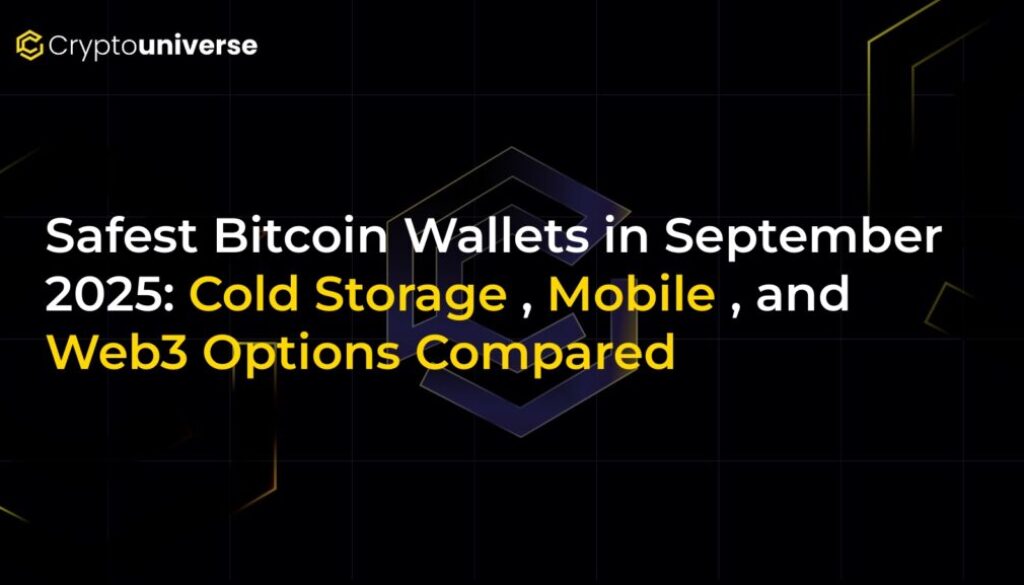Safest Bitcoin Wallets in September 2025: Cold Storage, Mobile, and Web3 Options Compared

Securing Your Bitcoin in 2025: A Guide to the Safest Wallets
Welcome to September 2025. The crypto landscape has evolved, and with Bitcoin solidifying its position as a premier store of value, the importance of secure self-custody has never been greater. The age-old mantra, “Not your keys, not your coins,” echoes louder than ever as on-chain activity grows and threats become more sophisticated. Choosing the right wallet is no longer just a technical decision—it’s the foundation of your digital sovereignty.
But with a dizzying array of options, how do you find the best fit? This guide breaks down the
First, What Makes a Bitcoin Wallet “Safe”?
Before we dive into specific products, let’s define what “safe” means in 2025. Security isn’t a single feature; it’s a multi-layered concept built on:
- Private Key Control: The wallet must give you, and only you, full control over your private keys. This is the essence of self-custody.
- Code Transparency: Open-source software is generally preferred as it allows security researchers to audit the code for vulnerabilities.
- Robust Security Features: This includes support for passphrases (a “25th word”), multi-signature (multisig) capabilities, and secure hardware elements.
- Reputation and Reliability: A long track record of security and consistent updates is a strong indicator of a trustworthy wallet.
The Fortress: Best Hardware Wallets
For long-term holding, nothing beats cold storage. These hardware devices keep your private keys completely offline, isolated from internet-connected computers and the threats they carry. They are the gold standard for securing significant amounts of Bitcoin.
1. Ledger (Stax / Nano S Plus)
Ledger remains a dominant force in the hardware wallet space. Its devices are built around a certified Secure Element (SE) chip, similar to what’s used in passports and credit cards, providing a powerful layer of physical security.
- Best For: Users who want a balance of top-tier security and a user-friendly experience.
- Key Features: The Ledger Live app provides an all-in-one interface for managing assets. The Ledger Stax, with its E-Ink display, has set a new standard for usability, while the Nano series remains a reliable and affordable entry point.
- Considerations: The company’s “Ledger Recover” service, an optional key recovery subscription, has been a point of debate in the community. While it offers a backup for less technical users, purists argue it introduces a potential trust-based vulnerability.
2. Trezor (Safe 5 / Model T)
Trezor is the original hardware wallet pioneer and a champion of the open-source ethos. Every line of its software and hardware design is public, allowing for complete transparency and community auditing.
- Best For: Open-source advocates and users who prioritize transparency above all else.
- Key Features: The Trezor Safe 5 and Model T feature a large touchscreen for on-device transaction verification, which is a critical security step. Its Shamir Backup feature allows you to split your seed phrase into multiple shares for redundant, geographically distributed backups.
- Considerations: Unlike Ledger, Trezor does not use a Secure Element chip, relying instead on its open-source architecture and other security measures.
3. Coldcard Mk4+ (or later)
If Bitcoin security were a spectrum, Coldcard would be at the most paranoid—and safest—end. Designed for Bitcoin maximalists, it’s a no-frills, security-first device that prioritizes function over form.
- Best For: Bitcoin purists and highly security-conscious users.
- Key Features: Coldcard is famous for its “air-gapped” functionality. You can conduct entire transactions using a microSD card, meaning the device never needs to be physically connected to a computer. It includes numerous anti-tampering features and is built to be a true digital vault.
- Considerations: The learning curve is significantly steeper than for Ledger or Trezor. It is not designed for beginners or for managing multiple cryptocurrencies.
On-the-Go Security: Top Wallets
Mobile wallets, or “hot wallets,” keep your keys on your internet-connected smartphone. While inherently less secure than cold storage, they are essential for everyday spending and managing smaller amounts of Bitcoin. The best mobile wallets in 2025 are non-custodial and packed with features.
1. BlueWallet
BlueWallet is a powerful, Bitcoin-only wallet that has become a favorite among both new and experienced users. Its focus on the Bitcoin ecosystem allows it to offer advanced, tailored features.
- Best For: Anyone looking for a versatile mobile Bitcoin experience.
- Key Features: Excellent Lightning Network integration for fast, cheap payments. It also offers advanced features like connecting to your own node, creating multisig vaults, and Plausible Deniability (a second, decoy wallet).
2. Muun Wallet
Muun has gained popularity for its incredibly simple user interface backed by a clever security model. It abstracts away the complexity of the Lightning Network and on-chain transactions into a single balance.
- Best For: Beginners who want a seamless self-custody experience.
- Key Features: Muun uses a 2-of-2 multisig setup where you hold one key and their server holds the other (which is only usable with your password). This enhances security against device theft while still providing full self-custody through a multi-step emergency recovery kit.
The New Frontier:
The concept of Web3 has expanded to Bitcoin, primarily through Layer 2 solutions like Stacks and the growth of Bitcoin-based DeFi. Web3 wallets are typically browser extensions or mobile apps that act as your gateway to this interactive ecosystem.
1. Xverse Wallet
As the premier wallet for the Stacks ecosystem, Xverse is the key to unlocking Bitcoin-based dApps, NFTs (Ordinals), and DeFi protocols.
- Best For: Users interested in exploring Bitcoin Ordinals and Layer 2 applications.
- Key Features: Provides a single interface for managing BTC, STX tokens, and Ordinals. It allows you to connect to decentralized applications built on the Stacks layer, which settles its transactions on the Bitcoin blockchain.
- Considerations: Security is paramount here. Interacting with smart contracts always carries inherent risks, so this type of wallet is best used with smaller, non-essential funds.
2. MetaMask (with Bitcoin Snaps)
While traditionally an Ethereum wallet, MetaMask’s “Snaps” system has opened it up to non-EVM chains, including Bitcoin. This allows users to manage their Bitcoin from the world’s most popular Web3 interface.
- Best For: Experienced Web3 users who want to manage multiple assets in one place.
- Key Features: The Snaps system allows for community-developed plugins to add Bitcoin functionality directly into the MetaMask interface.
- Considerations: This is a newer and more complex setup. The security of your Bitcoin depends on the quality and audit status of the specific Snap you install. It’s a powerful tool for experts but may introduce risks for beginners.
Conclusion: How to Choose Your Wallet
There is no single “best” wallet—only the best wallet for your specific needs. The safest strategy in 2025 is a hybrid approach:
- For your savings (90%+ of your holdings): Use a top-tier cold storage hardware wallet like a Ledger, Trezor, or Coldcard. Keep it secure and access it infrequently.
- For your spending money: Use a reputable mobile wallet like BlueWallet or Muun. Keep only what you’re comfortable losing on it, just like cash in a physical wallet.
- For exploring: If you’re venturing into Bitcoin DeFi or Ordinals, use a dedicated Web3 wallet like Xverse. Fund it with a small, experimental amount of Bitcoin from your mobile wallet.
By understanding the strengths and weaknesses of each category, you can build a robust, multi-layered security setup. In the world of Bitcoin, taking control of your keys is the ultimate form of financial empowerment. Choose wisely and stay secure.


